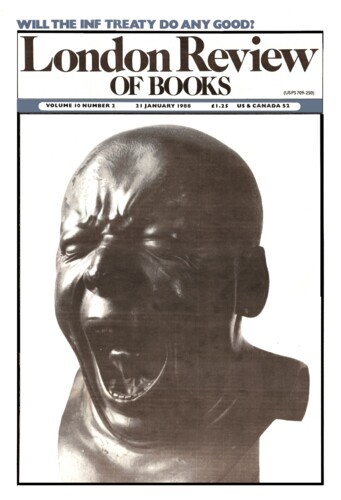This is a collection of fascinating studies, ranging from Babylon to 20th-century Ghana, from China to Madagascar. David Cannadine, in his Introduction, says that the topics covered are mainly pre-modern and therefore outside the scope of most professional historians. In their Acknowledgments, however, the two editors refer to the ‘rites of passage’ of contemporary heads of state, ‘from Reagan’s inaugural to Andropov’s funeral’, and admit that rituals continue to play a part in modern political systems. Indeed, in contemporary Britain we are not spared the rituals of royalty projected by the media. But are these for us (or some of us) simply entertainment? Averil Cameron, in her excellent contribution on Byzantium, asks: ‘Was there a Byzantine Princess Diana?’ She comments on the fervour accompanying British royal occasions and suggests that, as far as the mass of the Byzantine population was concerned, little warmth or affection was shown for the emperors. The editors are right: rituals are still perceived, at any rate by those who organise them, as playing important social and political roles. Professional historians of the modern period, as well as others, would do well to take ritual seriously. They may discover that its role hasn’t changed as much as one would think it had, despite the disappearance, at any rate in the industrialised world, of ‘traditional’ societies.
‘Traditional societies’, though, is much too vague. There are important differences between prehistoric or historic societies based on pastoral and gathering economies; ancient urbanised societies; various forms of feudalism. They should not be collapsed into each other. If this concept of traditional societies has, to some extent, influenced the writers in this collection, it may be responsible for a tendency to ignore the over-all structures of the societies whose royal rituals are studied.
The subtitle of the book indicates one of the primary aims of these studies. What was the relation between the rituals of royalty and the exercise of royal power? Did ritual simply reflect and legitimate the established power of kings and emperors? Or did it have a more positive part to play in the assertion of power? The authors’ answers to this problem vary, as would be expected, since they are dealing with vastly differing social orders. In some, legitimation would suffice; in others, rituals may have been a positive requirement for the exercise of power.
Legitimation of royal power and social order was clearly one of the primary aims of ritual. This emerges from all of the contributions. Amélie Kuhrt shows that the ritual of the many changing kings of Babylon, in acknowledging the city god, Marduk, took place because he symbolised a divine order, was a guardian against chaos and when angry with misrule replaced bad by good kings – a useful legitimation of conquest or usurpation. According to Simon Price, the symbolic apotheosis to divinity of the Roman emperors from their funeral pyre, with Senatorial control of the deification process in judging the ‘candidate’s’ virtue, reconciled republican and imperial ideologies. The rituals described by the tenth-century Byzantine emperor Constantine VII in his Book of Ceremonies were intended to emphasise harmony under imperial power, an emphasis especially directed at foreigners and the emperor’s subjects. Janet Nelson’s account of Carolingian ritual, especially under Charlemagne, interestingly downgrades its profile. She presents Charlemagne as un-autocratic, socially agreeable to the Frankish imperial nobility and to the higher clergy. It was the clergy who emphasised an ideology of hierarchy and obedience. Nevertheless, many of the emperor’s non-liturgical rituals, such as feasting, hunting and gift exchange, were, it seems, none the less effective. We move to an entirely different world in David McMullen’s description of the cosmology of T’ang China in the eighth century. Here again, the Confucian social order is legitimated as a reflection of the cosmos, but the imperial ritual is extraordinarily bureaucratised. The ritual code was organised in five sub-divisions: propitiatory rites, rituals for foreign guests, army rites, rites of passage, and rites for bad omens, such as bad harvests. There were four ritual courts and a board of rites. Thousands of officials supervised the rituals, as part of a normal bureaucratic career. As one would expect, the religious aspect tended to give way to an emphasis on the moral and social aspects of the ideology. Divine kingship, as Richard Burghart shows, was alive and well in Nepal as late as the 18th century, where the king was one among many gods. Present also was the not unfamiliar theme of the social hierarchy symbolised by the body, with the king as head. The main rituals seem to have been associated with grants of land to divine representatives (such as temples) in order to win divine assent for territorial conquest. There is also a hint of another link between ritual and power beyond mere legitimation. Harm to the king’s body in war was said to demoralise soldiers and to bring defeat: ‘Disorder in the body entailed disorder in the reign.’ But when land and labour became subject to market forces, so the author tells us, royal control diminished.
Contributions by two anthropologists encourage us to look at aspects of rituals of royalty other than the legitimation processes briefly summarised above – by no means the only issue considered by the authors. A problem which obviously presents itself when any sort of ritual (not only royal) is considered as a legitimation of power is: upon whom is this ritual intended to operate? If a royal ritual is conceived of as the symbol and legitimation of a social order, one would assume that it would be projected towards all classes in the given society. One would expect a historian describing this sort of legitimation process to consider, however briefly, the class structure of the society concerned. This would be in order to question the extent to which peasants, urban artisans, shopkeepers and merchants, as well as landowning élites, needed to be influenced by the ritual before they could accept that the unequal society to which they belonged was a reflection of a cosmic order which was not to be put into doubt.
Most of the contributions suggest that insofar as the rituals project a legitimation of regal power and social order, that projection does not go very far. The message of the various rituals of the kings of Babylon, supported by temple and city, appears to go no further down than to a group of privileged citizens. The senators and the knights of imperial Rome seem to have been the only people involved in the deification process. The ‘populace’ was excluded even though they must have been spectators. Byzantine rituals were not addressed to the masses but concerned relations between the emperor, the office-holding élite and the higher clergy. In the more relaxed Carolingian state, the only wider audience which might observe rituals were those bystanders who watched imperial involvement in processions to the relics of saints. Janet Nelson states explicitly that, in the sources of the period, populus in fact means the Frankish aristocracy. In eighth-century China, as one would expect in such a heavily bureaucratised society, ‘rules of ceremony do not go down to the common people,’ in spite of some evidence of offerings to the gods, at the village level, of grain and soil. And although the kings of Nepal had a relationship with the gods ‘which served to structure the authoritative relations between king and commoner’, the only hint of these relations is the example quoted above of the reactions of the Gurkha soldiers to the wounding of the king.
It may well be that our lack of knowledge of the downward projection of the message of the royal rituals is due to simple lack of evidence. In societies where the mass of the population was illiterate, lack of evidence is inevitable. In the few cases where any of the literate cared to describe the feelings of the illiterate, such descriptions could be determined by the social attitudes of the writer. It is here that the descriptions by anthropologists of royal rituals in Madagascar and in Ghana, drawing on recent and contemporary evidence, throw extra light on the efficacy of ritual from top to bottom of the social scale.
Maurice Bloch describes in great detail the ceremony of the royal bath at the beginning of the agricultural year in Madagascar. There was a complex series of rituals involving a veto on funerals, a hierarchically-ordered giving of gifts, organised weeping for the dead, sexual orgy followed by everybody retreating to their proper domestic place, the bath itself, the ritual meal and a distribution of cattle from superiors to inferiors. The king is represented as the father of his subjects, and the author is able to show that these rituals of royalty are analogous to non-royal rituals among the people. Royal rituals, therefore, have an emotional resonance down the social scale.
Similarly, Michelle Gilbert describes the kingdom of Akuapem in Ghana, where conquerors and conquered, two languages, and matrilineal and patrilineal clans, had to be brought into order under a hierarchy of gods. She shows that royal rituals, if not as widely connected with non-royal rituals as in Madagascar, were nevertheless not narrowly confined. The lowering of a chosen king onto the Black Stool was the crucial element in his achievement of power, but the stool was in fact also the symbol of ancestral power in all the important lineages. While the complex process of the election of a king was controlled by a leading clan and the rituals controlled by representatives of the patrilineal clans, it involved a considerable number of people including the senior women in the royal lineage.
It may be that the search for links between royal rituals and other rituals lower down the social scale is encouraged by the anthropological discipline. Maurice Bloch writes: ‘Royal symbolism is
Send Letters To:
The Editor
London Review of Books,
28 Little Russell Street
London, WC1A 2HN
letters@lrb.co.uk
Please include name, address, and a telephone number.


